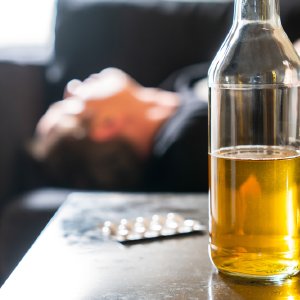America’s Deadly Drinking Problem

Much of the focus on alcohol consumption in the U.S. is directed at binge drinking, heavy drinking, and alcohol addiction. And not without good reason. Excessive drinking alone represents about 77% of the $249 billion the U.S. spends on addressing the damage caused by alcohol consumption each year. But that means the other 23% of the costs and harms of alcohol consumption is caused by allegedly “normal” and “safe” consumption.
When examining America’s drinking problem, it is crucial to address excessive drinking, problem drinking, and alcohol addiction. But it’s also important to address what is often thought of as “normal” drinking. The truth is, there is NO form of healthy or “normal” drinking. Individual Americans and the nation as a whole would be much healthier if people drastically reduced alcohol consumption or eliminated it entirely.
Binge Drinking, Heavy Alcohol Use, and Alcohol Addiction – What Do These Terms Refer To?
The National Institute on Alcohol Abuse and Alcoholism has laid out terminology to define different levels of alcohol consumption. The following are three categories of problem drinking that are often discussed:
- Binge Drinking: The NIAAA defines binge drinking as a pattern of drinking that brings blood alcohol content levels to 0.08 g/dl (grams per deciliter) or higher. This blood alcohol content level usually occurs after four drinks for a woman or five drinks for a man in two hours.
- Heavy Alcohol Use: Heavy alcohol use is defined as a behavioral pattern that involves engaging in binge drinking on five or more days in the past month.
- Alcohol Addiction: Alcohol addiction is defined in the context of someone who drinks to excess and who cannot control their drinking. Their alcohol consumption is compulsive, they cannot stop drinking on their own, and their drinking leads to harmful consequences which are not enough to deter the individual from continuing to drink.
The Harm of Drinking to Excess

Drinking too much alcohol is harmful in many ways. For one, it is extremely costly. According to the Centers for Disease Control and Prevention, the cost of excessive alcohol use in the U.S. was almost a quarter trillion dollars in 2010. About 95,000 people die in the U.S. from alcohol-related harm each year, and the loss to workplace productivity and household security is staggering.
Drinking too much alcohol harms the body. Alcohol interferes with the brain’s communication pathways. It can change mood and behavior. Alcohol can make it more difficult to think clearly, to move with coordination, and to make good, healthy, sensible decisions. Alcohol consumption can harm the heart too, causing long-term health conditions if one drinks too much for too long.
The liver and pancreas are also adversely affected by alcohol consumption. Both organs can develop long-term, even fatal diseases as a result of problem drinking. Several cancers have been linked to alcohol consumption (particularly to problem drinking and excessive drinking).
Finally, alcohol has a dampening effect on the immune system, even for those who do not drink to excess. When a person consumes alcohol, it can inhibit their body’s ability to fight off infections for up to 24 hours after drinking. That means people who drink alcohol may be more likely to get sick than those who do not.
Even “Normal” Drinking is Harmful – A Look at Per Capita Alcohol Use and Why That Matters
There is a consensus that drinking too much alcohol is harmful. But what about “normal” drinking patterns? The Dietary Guidelines for Americans 2020-2025 from the U.S. Department of Health and Human Services define moderate alcohol consumption as follows: “Adults of legal drinking age can choose not to drink, or to drink in moderation by limiting intake to 2 drinks or less in a day for men and 1 drink or less in a day for women, when alcohol is consumed. Drinking less is better for health than drinking more. There are some adults who should not drink alcohol, such as women who are pregnant.”
While the guidelines do mention that drinking less is better for one’s health than drinking more, the guidelines do not touch on the risks and dangers of drinking alcohol even when alcohol is consumed within the accepted standard of “normal” drinking.
One could make a logical argument that when a large percentage of a country’s population consumes alcohol, there will be more people in that population who end up misusing alcohol. Keep in mind that, according to the NIAAA, 85% of the U.S. adult population has drunk alcohol at least once, 69% have done so in the past year, and 54% have done so in the past month.
A study published in the Journal of Studies on Alcohol and Drugs found a strong link between a population’s total number of alcohol drinkers and the number of people who drank to excess. The more people who drank any amount of alcohol, the more people within that population drank excessively.
And this makes sense, logically, as most people who drink to excess began by drinking in moderation.

Quoting study authors Rossow and Mäkelä, “Substantial literature demonstrates quite consistently close associations between APC (alcohol per capita consumption) and population harm levels for various types of health and social harms. By reducing APC, decreases in drinking among heavy drinkers as well as among ordinary drinkers will lead to fewer alcohol-related harms. The evidence strongly suggests public health gains from universal policies targeting APC.”
According to another NIAAA research document, the per capita consumption of alcohol in the United States is growing. Per capita consumption of all alcoholic beverages in 2016 was 2.35 gallons, which represents a 0.9% increase from 2.33 gallons consumed per capita in 2015. This increase occurred during a Healthy People 2020 collaborative public health effort to reduce per capita consumption.
Despite nationwide efforts to get the American people to drink less, they’re drinking more.
Staying Healthy, Safe, and Well – Reduce Risk by Abstaining from Alcohol
The truth is, alcohol just isn’t worth it. To stay healthy and well, Americans should reduce their alcohol consumption (if not eliminate it completely). Remember, any form of drinking presents a risk. The only way to stay healthy, safe, and well is to not drink at all.
Sources:
- https://www.niaaa.nih.gov/publications/brochures-and-fact-sheets/alcohol-facts-and-statistics
- https://www.cdc.gov/alcohol/features/excessive-drinking.html
- https://www.niaaa.nih.gov/alcohols-effects-health/alcohols-effects-body#:~:text=Here's%20how%20alcohol%20can%20affect,clearly%20and%20move%20with%20coordination.
- https://www.dietaryguidelines.gov/sites/default/files/2021-03/Dietary_Guidelines_for_Americans-2020-2025.pdf
- https://www.jsad.com/doi/10.15288/jsad.2021.82.9
- https://pubs.niaaa.nih.gov/publications/surveillance110/CONS16.htm
Reviewed by Claire Pinelli, ICAADC, CCS, LADC, RAS, MCAP, LCDC-I


 ®
®